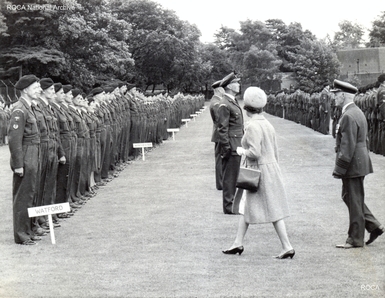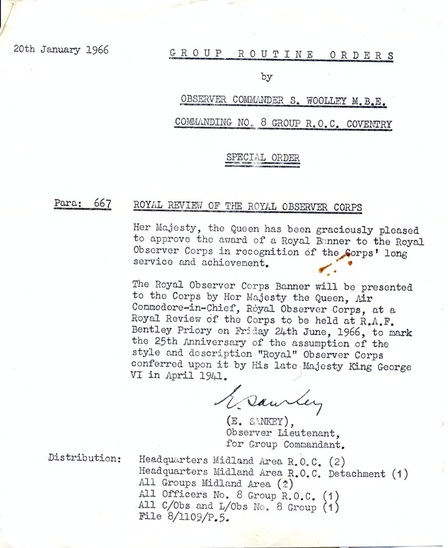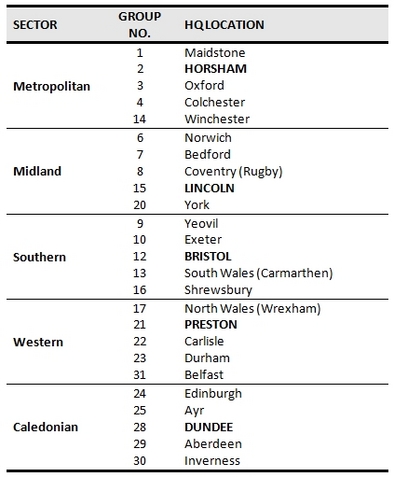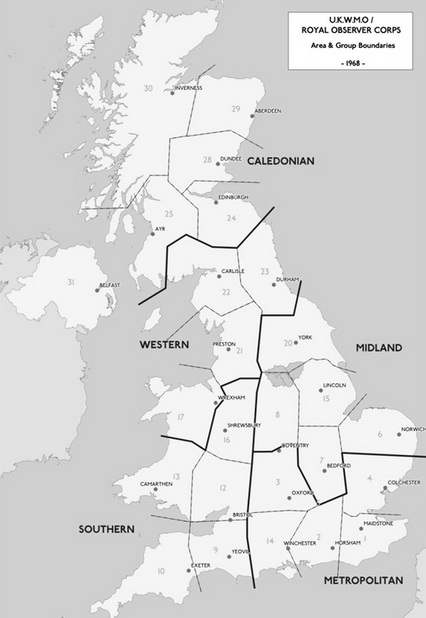1960's - 1980's: Reviews, Defence Cuts & Change

Her Majesty Queen Elizabeth II at the Royal Review of the ROC in 1966
Overground ... Underground
The early 1960's saw the initial redevelopment of the Corps' with the completion of the majority of the underground monitoring posts by 1963/4 as developed through the programme of building works initiated the previous decade. In total 1,563 underground posts were constructed along with a further 31 protected centre buildings.
The basic cost of building a post was £1,250* however local variations caused such prices to vary between £1,000* and £2,000*. Costs for building the centres was higher and depending on the type of centre building built. Semi-sunk centres which consisted of the majority of the building underground were approximately £45,000* to build, whilst surface buildings above ground were slightly cheaper at £41,000*
Royal Review
On the 24th June 1966 the Queen attended a special event at RAF Bentley Priory. The day formed the Royal Review of the Corps' and which marked the 25th anniversary of the assumption of the style and awarding of the 'Royal' title in 1941. The occasion also saw the Queen award the Corps' with their banner in recognition of the corps' long service and achievements from its beginnings and through WW2.
The Queen upon arrival was presented to the Commandant of the ROC, Air Commodore J.H. Greswell, CBE, DSO, DFC and the officer commanding the headquarters unit, Fighter Command, Wing Commander N. Mackie DSO, DFC by the A.O.C in Command of Fighter Command, Air Marshal F.E Rosier, CB, CBE, DSO. Later the Queen inspected 756 ROC personnel, drawn from all ROC groups, before the official dedication and presentation of the banner was undertaken and after which, the banner was slow marched onto the parade to the strains of the National Anthem.
The early 1960's saw the initial redevelopment of the Corps' with the completion of the majority of the underground monitoring posts by 1963/4 as developed through the programme of building works initiated the previous decade. In total 1,563 underground posts were constructed along with a further 31 protected centre buildings.
The basic cost of building a post was £1,250* however local variations caused such prices to vary between £1,000* and £2,000*. Costs for building the centres was higher and depending on the type of centre building built. Semi-sunk centres which consisted of the majority of the building underground were approximately £45,000* to build, whilst surface buildings above ground were slightly cheaper at £41,000*
Royal Review
On the 24th June 1966 the Queen attended a special event at RAF Bentley Priory. The day formed the Royal Review of the Corps' and which marked the 25th anniversary of the assumption of the style and awarding of the 'Royal' title in 1941. The occasion also saw the Queen award the Corps' with their banner in recognition of the corps' long service and achievements from its beginnings and through WW2.
The Queen upon arrival was presented to the Commandant of the ROC, Air Commodore J.H. Greswell, CBE, DSO, DFC and the officer commanding the headquarters unit, Fighter Command, Wing Commander N. Mackie DSO, DFC by the A.O.C in Command of Fighter Command, Air Marshal F.E Rosier, CB, CBE, DSO. Later the Queen inspected 756 ROC personnel, drawn from all ROC groups, before the official dedication and presentation of the banner was undertaken and after which, the banner was slow marched onto the parade to the strains of the National Anthem.
|
This document is the official opening brochure for the new Group Headquarters and operations room for 18 Group based in Leeds, West Yorkshire. The building which is still extant is location at Yeadon near to Leeds Bradford Airport. The building opened in 1964 and closed 4 years later in 1968 as a result of the ROC reorganisation (See below).
| ||||||
Further Reorganisation
Economic constraints during the mid to late 1960s led to reduced defence spending by the UK Government and ultimately led to a need to reduce defence spending by the Government. In 1962, the forty ROC Groups from 1953 were reorganised and reduced in number to thirty one, with a further reduction to twenty five taking place in 1968, including the control in Lisburn, Northern Ireland. Service age limits of 16 to 65 were introduced, with service after the age of 65 only occurring where replacements could not be recruited, subject to annual review, and where appropriate medical certificates could be provided.
As part of the Government’s Home Defence review during 1968, the Government decided to reduce home defence (civil defence) to a care and maintenance basis and disband the Civil Defence Corps, Auxiliary Fire Service and the Territorial and Army Volunteer Reserve (Category III). Concerns by ROC members in respect to these defence cuts ultimately led to the issue of a letter for communication to all ROC members by Observer Captain W. Rusby on 17th January 1968. The letter highlighted that;
“The Warning and Monitoring Organisation and therefore the ROC was not included in the “Civil Defence” decision and is to continue in being, but is subjected to a severe financial cut that will impose the need for reappraisal of tasks for the Corps and organisation required to meet the reduced requirements ... it is clear (however) that a scaling down of activity will be inevitable”.
As a result of this scaling down of the ROC activity it was decided that the number of underground monitoring posts throughout Great Britain & Northern Ireland would be reduced from 1,563 to 873 from 1st April 1968. At the same time a sector and group reorganisation led to the Group Headquarters at Watford (No.5 Group) and Leeds (No.18 Group) being disbanded and staffing reduced by half to approximately 324 spare-time officers and 12,300 observers.
The reorganisation of the sectors in 1968 reduced the total number from 6 to 5. Each of these sectors had five UKWMO Groups within them and each group had an underground headquarters; with one of these being the sector control headquarters. Each group had a number of Monitoring Posts, varying between 27 and 58 and spaced between 10 and 15 miles apart. These monitoring posts reported directly to the Group control.
The PDF file below relates to the closure of the Watford Group Control in 1968 as a result of the reorganisation.
The reorganisation of the sectors in 1968 reduced the total number from 6 to 5. Each of these sectors had five UKWMO Groups within them and each group had an underground headquarters; with one of these being the sector control headquarters. Each group had a number of Monitoring Posts, varying between 27 and 58 and spaced between 10 and 15 miles apart. These monitoring posts reported directly to the Group control.
The PDF file below relates to the closure of the Watford Group Control in 1968 as a result of the reorganisation.
| Watford Group Closure 1968 | |
| File Size: | 488 kb |
| File Type: | |
Nuclear Reporting Cells: “The Secret Corps”
During the 1970s and as a development of the Special Nuclear Operations Teams created in 1958 at RAF Bentley Priory, a new class of observer was created to operate specialist Nuclear Reporting Cells (NRC). These NRC’s were located at selected strategic armed forces Headquarters across the country. The initial role of the NRC observers was to provide the army, navy and air force with comprehensive visual displays and scientific interpretation of the information provided by the ROC group controls with respect to nuclear bomb bursts and radioactive fallout dispersal. Their role combined basic ROC training (as other Monitoring Posts and group control staff) and duties with some of the scientific skills and training of the Home Office warning teams. Higher levels of security clearance and specialist training were needed for the limited number of NRC observers as a result.
| NRC Operating Procedures | |
| File Size: | 2363 kb |
| File Type: | |
Notes:
* - 1960's Prices
Image Source: ROCA National Archive
Map Source: South Yorkshire ROC Collection


